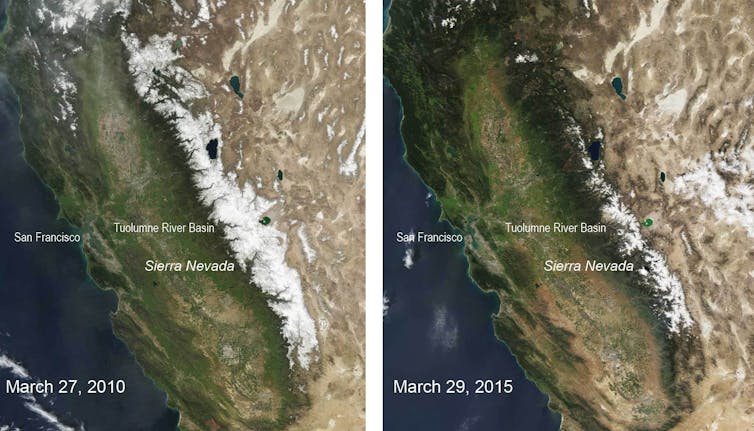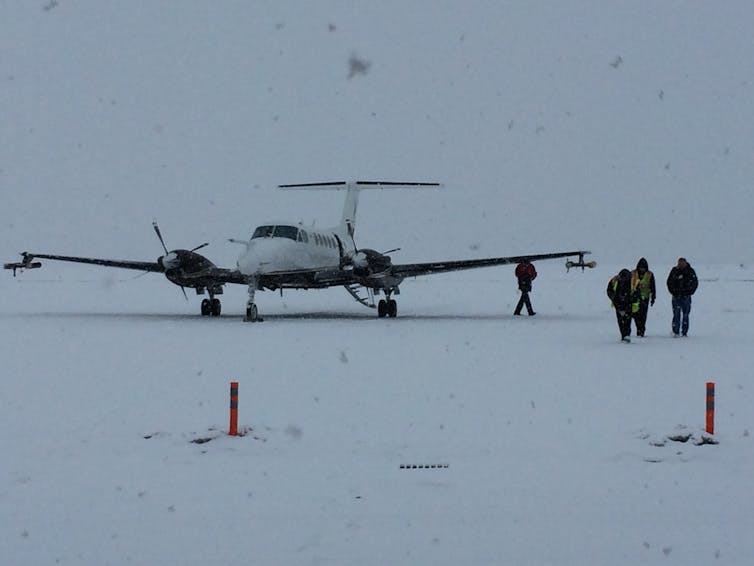Does cloud seeding work? Scientists watch ice crystals grow inside clouds to find out
- Written by Jeffrey French, Assistant Professor of Atmospheric Science, University of Wyoming
Water is a valuable resource that affects nearly all aspects of life on earth. It also is limited, so people use a variety of methods to ensure that supply meets demand.
One such technique is cloud seeding – adding particles to the atmosphere to promote formation of rain or snow. Today many entities across the West – including state and local goverment agencies, utilities and ski areas[1] – seed clouds in an effort to boost winter snowfall in the mountains. More snowpack means more spring and summer runoff, which feeds local water supplies, irrigates crops and fuels dams that generate hydroelectric power.
Cloud seeding has also been used in efforts to disperse fog at airports[2], boost summer rainfall[3] and reduce hail[4]. In fact, cloud seeding occurs in more than 50 countries worldwide[5]. Yet despite all of this activity, we still don’t know whether it works.
We are atmospheric[6] scientists[7] and recently conducted a field study[8] to evaluate cloud seeding as a means of enhancing mountain snowpack from winter storms. Our results[9] clearly demonstrate that, at least under certain conditions, it is possible to change the evolution and growth of cloud particles, leading to snowfall that otherwise would not have occurred. The next question is whether cloud seeding can be an effective tool for water managers in the western United States.
 Snow cover in California’s Sierra Nevada mountains in an average snowfall year versus a drought year. Snowpack is an important water source for western states.
NASA/Modis[10]
Snow cover in California’s Sierra Nevada mountains in an average snowfall year versus a drought year. Snowpack is an important water source for western states.
NASA/Modis[10]
Creating crystals inside clouds
Clouds are made up of water droplets that are too small to fall as precipitation. These droplets often supercool[11] to temperatures well below the freezing point – as low as 0 degrees Fahrenheit (minus 18 degrees Celsius) or colder. In many circumstances ice crystals (which can grow rapidly in the presence of supercooled liquid) must be present for a cloud to produce any significant amount of precipitation. For clouds that form as air is lifted over a mountain, if no ice crystals or too few of them are present, many of the water droplets that make up the cloud simply evaporate on the downwind side of the mountain.
Winter cloud seeding is based on a hypothesis that when supercooled water exists in a cloud, it can be modified by introducing particles that act as artificial ice nuclei[12]. This process creates ice crystals that will utilize the supercooled water to grow large enough that they eventually fall to the surface as snow.
Cloud seeding was pioneered by atmospheric scientist Bernard Vonnegut[13], brother of famed novelist Kurt Vonnegut. In 1947 Vonnegut’s lab showed that silver iodide was an effective ice nucleus[14] that could form ice at temperatures much warmer than naturally occurring ice nuclei.
Over the next 40 years, scientists studying cloud seeding made significant discoveries about nearly all aspects of cloud physics. Despite this, in 2003 the National Research Council concluded[15] that “there still is no convincing scientific proof of the efficacy of intentional weather modification efforts.” Nonetheless, states and communities pressed on with operational cloud seeding, while research on its effectiveness ground to a halt.
How snow forms, and sometimes becomes hail or sleet.The path to SNOWIE
Why do these programs exist without scientific evidence that they work? The answer is simple: Western states need water, and many decision-makers believe that cloud seeding can be a cost-effective way to produce it.
In 2004 the state of Wyoming commissioned a pilot project[16], which came to the same conclusion as many previous studies: Cloud seeding might have increased precipitation, but the increase could also be explained by natural variability in storm systems. However, a sister project[17] funded by the National Science Foundation demonstrated that new computer modeling tools and improved instrumentation could produce some new insights.
Meanwhile, Idaho Power Company was working with the National Center for Atmospheric Research[18] to evaluate the company’s ongoing operational cloud seeding program. From this collaboration came the idea to use new computer modeling tools and improved instrumentation to assess the effectiveness of Idaho Power’s cloud seeding program. The ultimate result was our project, Seeded and Natural Orographic Wintertime clouds: the Idaho Experiment, or SNOWIE[19].
From silver iodide to snow
In the winter of 2017, we set out armed with sophisticated radars, such as the Doppler on Wheels (DOWs)[20], which we positioned at mountaintop locations, and the Wyoming Cloud Radar (WCR)[21], which we mounted on a research aircraft[22]. These tools enabled us to peer into clouds in order to determine where and when precipitation was developing.
 Research aircraft with wingtip imaging probes.
Jeffrey French, CC BY-ND[23]
Research aircraft with wingtip imaging probes.
Jeffrey French, CC BY-ND[23]
After clouds were seeded with silver iodide particles, we used imaging probes that hung from the wings of research aircraft to examine fine details of cloud particles as the plane passed in and out of the seeded regions. Just two weeks into our 10-week field project, our radar detected the first undeniable signal of precipitation resulting from cloud seeding.
We saw clear and unambiguous signals that releasing silver iodide particles was initiating ice crystal formation, and that these crystals were growing into snow and falling to the mountain’s surface. Inside areas affected by seeding, the ice crystal concentrations increased by the hundreds leading to the formation of snow. In contrast, just 1 kilometer away in nonseeded cloud regions the cloud remained composed mostly of small liquid droplets and largely devoid of ice.
How could we tell that what we saw was actually due to cloud seeding? In one case, an aircraft passed back and forth along a straight track that was perpendicular to the wind direction, releasing silver iodide. The silver iodide began to disperse downwind through the cloud in a zig-zag plume – a pattern that was created by the aircraft’s flight pattern and would not have occurred naturally. We saw radar echoes forming in a zig-zag pattern that matched our prediction based on when and where the silver iodide was released in the clouds.
Can cloud seeding make a difference?
Now that we know cloud seeding can lead to snowfall, we want to see whether it can change the balance of water over an entire mountain range. Data from SNOWIE will be used in computer models to test our ideas of how cloud seeding might influence seasonal snowfall and quantify its impact. Ultimately, water managers and public officials will want to know how much additional precipitation can be produced because of cloud seeding, and whether it is a cost-effective way to augment precipitation in local watersheds.
Robert M. Rauber[24] of the University of Illinois, Katja Friedrich[25] of the University of Colorado, Bart Geerts[26] of the University of Wyoming, Roy Rasmussen[27] and Lulin Xue[28] of the National Center for Atmospheric Research, and Mel Kunkel[29] and Derek Blestrud of Idaho Power Company also participated in the SNOWIE study discussed in this article.
References
- ^ state and local goverment agencies, utilities and ski areas (www.nawmc.org)
- ^ disperse fog at airports (www.youtube.com)
- ^ boost summer rainfall (www.tdlr.texas.gov)
- ^ reduce hail (www.cbc.ca)
- ^ 50 countries worldwide (www.wmo.int)
- ^ atmospheric (scholar.google.com)
- ^ scientists (scholar.google.com)
- ^ field study (www.eol.ucar.edu)
- ^ Our results (doi.org)
- ^ NASA/Modis (commons.wikimedia.org)
- ^ supercool (en.wikipedia.org)
- ^ ice nuclei (glossary.ametsoc.org)
- ^ Bernard Vonnegut (www.nytimes.com)
- ^ an effective ice nucleus (doi.org)
- ^ National Research Council concluded (www.nap.edu)
- ^ Wyoming commissioned a pilot project (wwdc.state.wy.us)
- ^ sister project (www.eol.ucar.edu)
- ^ National Center for Atmospheric Research (ncar.ucar.edu)
- ^ SNOWIE (www.eol.ucar.edu)
- ^ Doppler on Wheels (DOWs) (www.cswr.org)
- ^ Wyoming Cloud Radar (WCR) (flights.uwyo.edu)
- ^ research aircraft (researchfeatures.com)
- ^ CC BY-ND (creativecommons.org)
- ^ Robert M. Rauber (scholar.google.com)
- ^ Katja Friedrich (scholar.google.com)
- ^ Bart Geerts (www.atmos.uwyo.edu)
- ^ Roy Rasmussen (scholar.google.com)
- ^ Lulin Xue (scholar.google.com)
- ^ Mel Kunkel (www.linkedin.com)
Authors: Jeffrey French, Assistant Professor of Atmospheric Science, University of Wyoming

